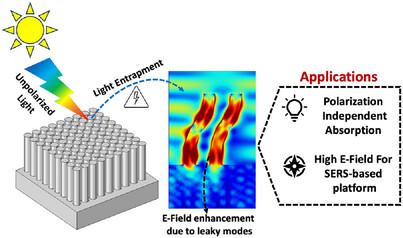非对称硅纳米结构中强可调谐偏振不相关光捕获的起源
IF 2.9
4区 工程技术
Q1 MULTIDISCIPLINARY SCIENCES
引用次数: 0
摘要
不依赖偏振的光捕获是推进太阳能收集和光谱技术的基石。采用有限元模拟方法,研究了几何形状、极化和漏模共振(LMR)对不同形态硅纳米柱(SiNPs)吸收和反射特性的影响。本文介绍了具有扭结形态的纳米柱,详细介绍了一种结合直线和倾斜SiNPs特征的混合设计,并表现出优异的偏振不敏感性和优异的吸收效率。结果表明,扭结SiNPs通过在横向电(TE)和横向磁(TM)极化上保持高吸收效率,利用其结构不连续来激发杂化引导模式和泄漏模式,从而优于同类产品。这些模式通过增加光程长度和促进更强的光-物质相互作用来增强光捕获。参数化研究进一步强调几何因素在优化光吸收中的关键作用,包括直径、倾角和柱间距离。由于其周围的局部电场增强,可以提高信号灵敏度,因此扭结SiNPs可以用作光捕获衬底,具有特殊的性能。这种增强的功能强调了从光谱学到可再生能源技术等各种用途的扭结sinp的潜力。本文章由计算机程序翻译,如有差异,请以英文原文为准。

Origin of Strong and Tunable Polarization-Independent Light-Trapping in Asymmetric Silicon Nanostructures
Polarization-independent light trapping is a cornerstone for advancing both solar energy harvesting and spectroscopic technologies. Using finite element method (FEM) simulations, the interplay of geometry, polarization, and leaky mode resonances (LMR) in modulating the absorption and reflection characteristics of different morphologies of silicon nanopillars (SiNPs) is investigated. Here, nanopillars with kinked morphology are introduced, a hybrid design combining features of straight and slanted SiNPs in detail, and demonstrate exceptional polarization insensitivity and superior absorption efficiency. The results reveal that kinked SiNPs outperform their counterparts by sustaining high absorption efficiency across both transverse electric (TE) and transverse magnetic (TM) polarizations, leveraging their structural discontinuities to excite hybridized guided and leaky modes. These modes enhance light trapping by increasing the optical path length and promoting stronger light-matter interactions. Parametric studies further emphasize the critical role of geometric factors in optimizing light absorption, including diameter, inclination angle, and interpillar distance. The kinked SiNPs may be utilized for exceptional performance as light-trapping substrates because of the enhanced localized electric fields in their surroundings that can enhance the signal sensitivity. This enhanced functionality underscores the potential of kinked SiNPs for a variety of uses, from spectroscopy to renewable energy technologies.
求助全文
通过发布文献求助,成功后即可免费获取论文全文。
去求助
来源期刊

Advanced Theory and Simulations
Multidisciplinary-Multidisciplinary
CiteScore
5.50
自引率
3.00%
发文量
221
期刊介绍:
Advanced Theory and Simulations is an interdisciplinary, international, English-language journal that publishes high-quality scientific results focusing on the development and application of theoretical methods, modeling and simulation approaches in all natural science and medicine areas, including:
materials, chemistry, condensed matter physics
engineering, energy
life science, biology, medicine
atmospheric/environmental science, climate science
planetary science, astronomy, cosmology
method development, numerical methods, statistics
 求助内容:
求助内容: 应助结果提醒方式:
应助结果提醒方式:


